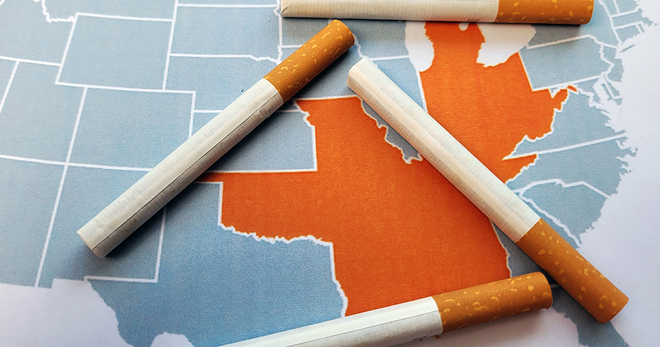5 insights about areas with the highest smoking rates in the U.S.
When it comes to tobacco use, a group of 12 states stretching from the upper Midwest to the South looks like some of the most tobacco-dependent — and less-developed — countries in the world. In fact, when compared with the Bloomberg Initiative’s 10 countries with the highest rates of tobacco use, it would rank in the top five.
How can it be that in the U.S., where smoking has dramatically declined in the last two decades, there are such high, concentrated rates of tobacco use?
Truth Initiative® convened public health experts to answer that question and discuss strategies for confronting the challenges facing these parts of the country. The discussion, part of the Truth Initiative conversation series on tobacco control called the Kenneth E. Warner Series, follows the release of “Tobacco Nation: The Deadly State of Smoking Disparity in the U.S.,” a report examining states with the highest rates of tobacco use. The Truth Initiative report terms the 12 contiguous states — Alabama, Arkansas, Indiana, Kentucky, Louisiana, Michigan, Mississippi, Missouri, Ohio, Oklahoma, Tennessee and West Virginia — “Tobacco Nation” and identifies factors that contribute to their high smoking rates, including lack of income, infrastructure, health care resources and tobacco control policies.
“It’s like there are two worlds now. It’s as if America is this restaurant where there is a nonsmoking section and a smoking section,” said Washington Post reporter William Wan, quoting a smoking cessation expert he interviewed for his story, “America’s New Tobacco Epidemic.”
Wan moderated the Warner Series discussion, which featured Corinne Graffunder, director of the Centers for Disease Control and Prevention Office on Smoking and Health; Alana D. Knudson, principal research scientist and co-director of the University of Chicago’s Walsh Center for Rural Health Analysis; Tracy Strader, former director of the Oklahoma Tobacco Settlement Endowment Trust; and K. “Vish” Viswanath, health communication professor at the Harvard School of Public Health.
Here are five insights from these experts about challenges and strategies for eliminating tobacco-related disparities across the country. For more, watch the full recording of the Warner Series: Tobacco Disparities in the U.S.
Consider the context of race, class and place.
Public health efforts over decades have helped bring down the smoking rate nationally, but “the benefits from our interventions are accruing unequally across race, class and place,” said Viswanath.
Income and education levels, race and ethnicity, and where individuals live, among other factors, have a profound impact on whether people smoke. These factors also influence whether people have experienced the benefits of proven tobacco control strategies.
“We know what works in tobacco control in so many more ways than we do in so many other public health areas,” said Graffunder, who described a “vaccine” that exists for tobacco use that is made of four proven strategies: quit smoking resources, hard-hitting media campaigns, smoke-free places and high tobacco prices. “It’s a combination of strategies that we have not been able to sufficiently deliver.”
Rural tobacco use shows disturbing trends.
Rural communities consistently have poorer health outcomes than those in other areas of the country. “There are great disparities when you look at rural [communities],” said Knudson, who studies rural health at the University of Chicago. He pointed out that many of the counties in Tobacco Nation are rural.
According to CDC data, people living in rural communities have 18 to 20 percent higher rates of lung cancer than people living in urban areas. Adolescents in rural areas also begin smoking cigarettes at an earlier age and are more likely to be daily smokers than their peers in other areas.
Knudson says she finds youth tobacco use in rural areas “particularly disturbing,” adding, “this means that we are going to continue to see these dipartites over time.”
Communities can have a culture of tobacco use.
“You’re really looking at a culture where this is acceptable, and we have to figure out ways to make health be the acceptable choice,” said Knudson, adding that you “can’t plug-and-play” prevention and quitting strategies from different parts of the country.
Knudson helps maintain the Rural Health Information Hub, which provides resources for and case studies of culturally appropriate strategies. One example: West Virginia’s Spit it Out project from the Southern Coalfields Tobacco Prevention Network, which focuses on special populations, including coal miners.
Tobacco industry influence in these states is a major obstacle.
“We talk a lot about personal responsibility, place, race and class, rural and so forth. All of these things matter and they matter deeply, but most of them wouldn’t matter nearly as much if we didn’t have that constant attack from the industry,” said Strader from Oklahoma, who told the audience that there are 12 to 15 tobacco lobbyists at the Oklahoma State Capitol every session. The tobacco industry works to block proven tobacco control strategies such as price increases and smoke-free spaces. “There are deep relationships that form.”
Oklahoma is also a state that has preemption laws, which prohibit localities from passing tobacco legislation that is stronger than state law and is “the equivalent of a huge wall put before us,” Strader said. Many states have preemption laws, which the tobacco industry often supports. For example, 14 states have smoke-free preemption laws. “That’s why we’ve taken the strategy of going city government to city government, school district to school district.” While that is movement in the right direction, Strader added: “That strategy is just not the most effective way to get broad scale change to occur.”
We need to fight “tobacco fatigue.”
Youth smoking is at an all-time low of 6 percent, but as Tobacco Nation states demonstrate, that number does not tell the whole story.
“There is a certain amount of tobacco fatigue right now where people think, ‘we’ve solved the problem. I don’t know why we are still talking about tobacco,’” Viswanath said. “We have to reframe this issue.” He added that combining successful, existing public education campaigns with grassroots communication will help “frame these issues for the public.” “What this does is allows us to not only rely on advertising or public communication campaigns, but also infusing through news media and other cultural vehicles that are important.”
Strader also stressed that communication efforts need to reach decision-makers, many of whom are not smokers. “We have to communicate to our business leaders, our community leaders, our elected officials and the people who vote for and support them, and oftentimes those folks are not in a smoking environment.”
For much more on this topic, watch the Warner Series recording. The Warner Series is named for Ken E. Warner, an economist by training, distinguished professor at the University of Michigan School of Public Health and a former board member at Truth Initiative. Warner is one of the leading voices in tobacco control. The series honors his ongoing contributions by regularly bringing together leaders across tobacco control, public health and youth service communities to engage in thought-provoking conversations about ways we can innovate and inspire action to save lives.
More in smoking by region
Want support quitting? Join EX Program
By clicking JOIN, you agree to the Terms, Text Message Terms and Privacy Policy.
Msg&Data rates may apply; msgs are automated.

